Systematic Review: Graduated Compression Stockings to Prevent DVT
VerifiedAdded on 2023/04/21
|65
|12058
|330
Report
AI Summary
This report is a systematic review investigating the impact of graduated compression stockings (GCS) on preventing deep vein thrombosis (DVT) in post-operative orthopaedic patients. A literature search was conducted using MEDLINE and CINAHL databases, focusing on studies related to GCS, DVT, and postoperative care. Four relevant articles were critically analyzed, revealing that while GCS may reduce DVT risks initially, the difference between GCS and standard therapy lacked significant statistical support. The review discusses the mechanism of action of GCS, its clinical implications, and highlights the need for multicenter randomized trials to confirm its effectiveness across broader populations. The study concludes that clinicians can consider GCS for DVT risk reduction in orthopaedic patients, but further research is necessary to validate these findings.
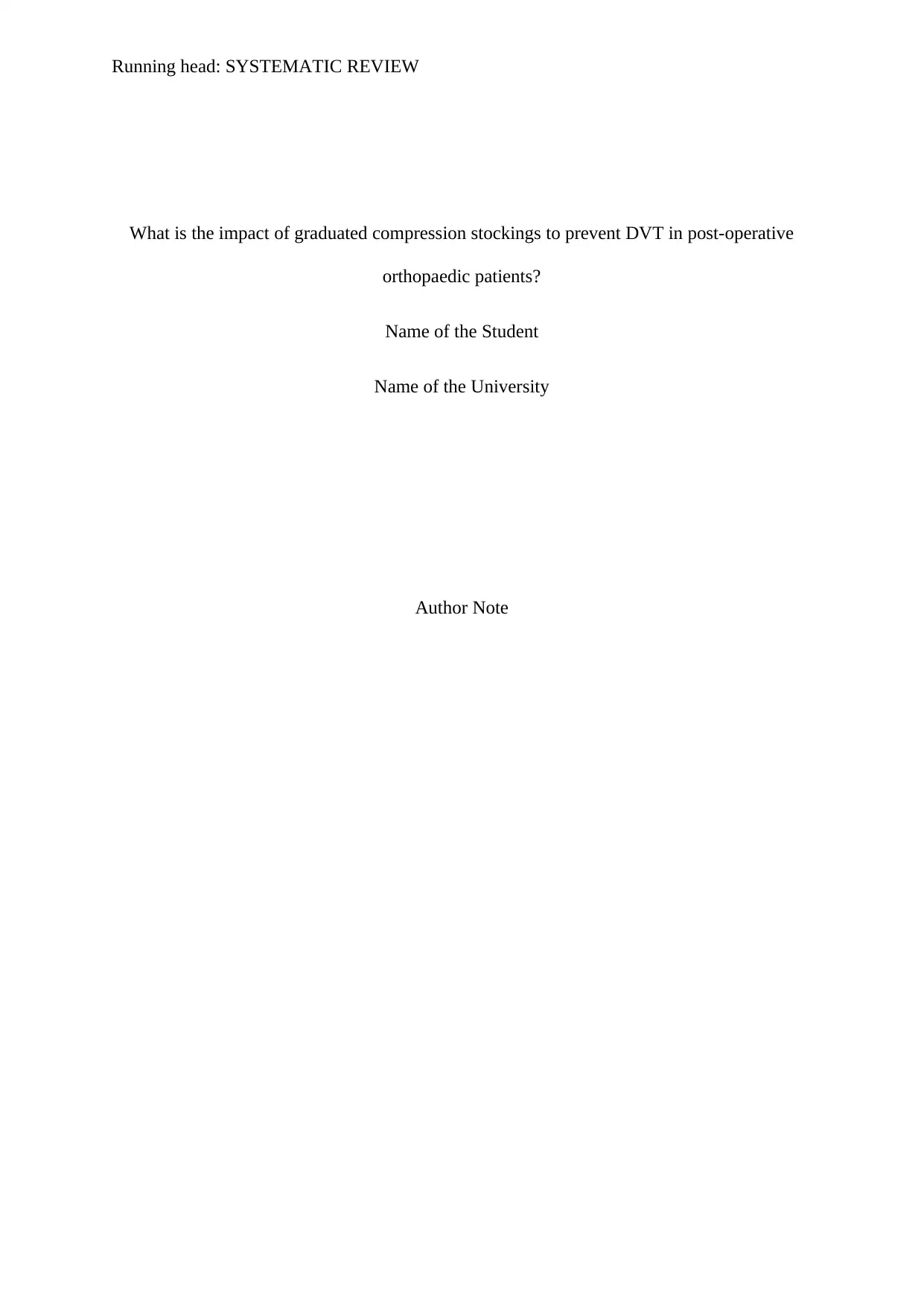
Running head: SYSTEMATIC REVIEW
What is the impact of graduated compression stockings to prevent DVT in post-operative
orthopaedic patients?
Name of the Student
Name of the University
Author Note
What is the impact of graduated compression stockings to prevent DVT in post-operative
orthopaedic patients?
Name of the Student
Name of the University
Author Note
Paraphrase This Document
Need a fresh take? Get an instant paraphrase of this document with our AI Paraphraser
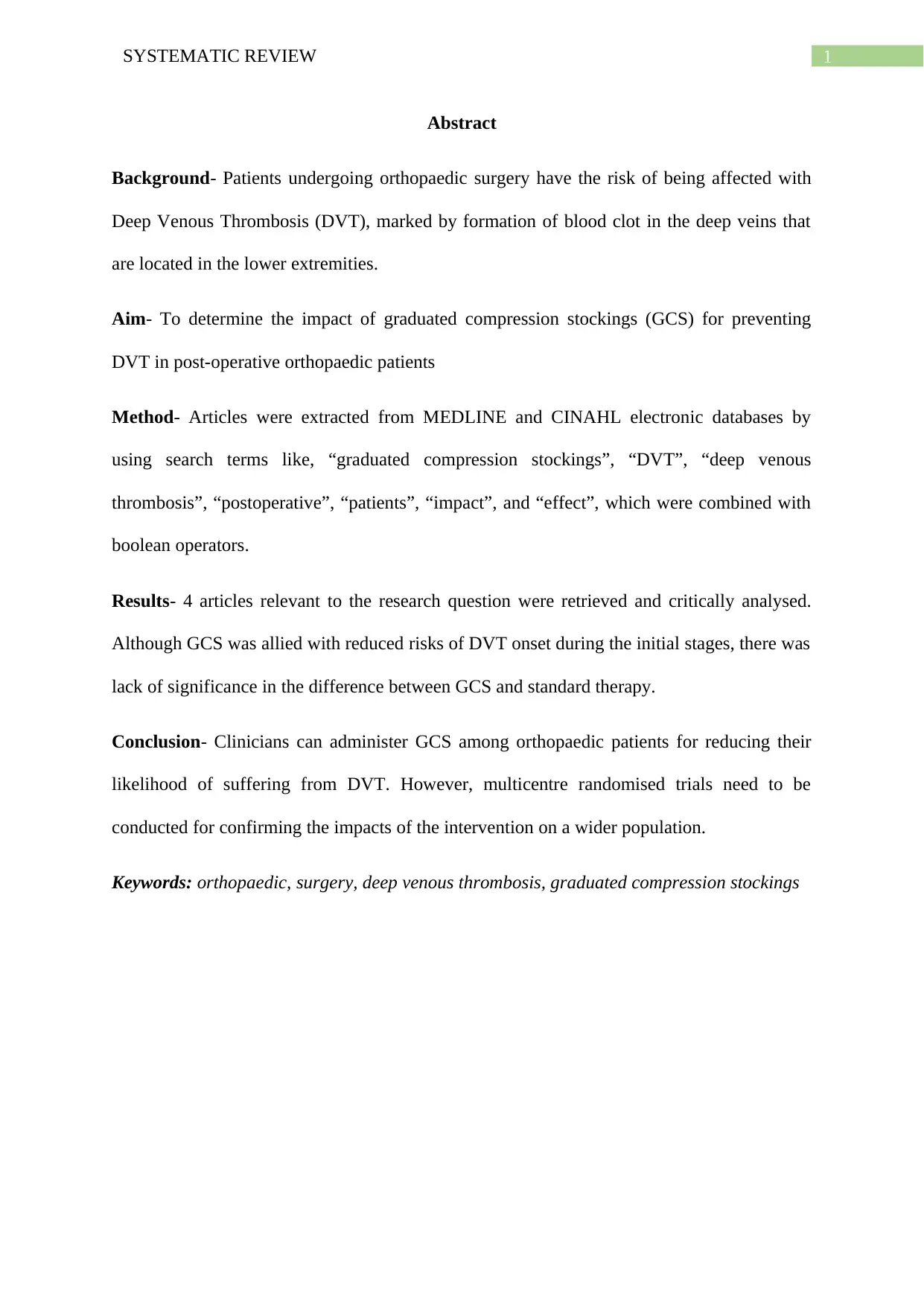
1SYSTEMATIC REVIEW
Abstract
Background- Patients undergoing orthopaedic surgery have the risk of being affected with
Deep Venous Thrombosis (DVT), marked by formation of blood clot in the deep veins that
are located in the lower extremities.
Aim- To determine the impact of graduated compression stockings (GCS) for preventing
DVT in post-operative orthopaedic patients
Method- Articles were extracted from MEDLINE and CINAHL electronic databases by
using search terms like, “graduated compression stockings”, “DVT”, “deep venous
thrombosis”, “postoperative”, “patients”, “impact”, and “effect”, which were combined with
boolean operators.
Results- 4 articles relevant to the research question were retrieved and critically analysed.
Although GCS was allied with reduced risks of DVT onset during the initial stages, there was
lack of significance in the difference between GCS and standard therapy.
Conclusion- Clinicians can administer GCS among orthopaedic patients for reducing their
likelihood of suffering from DVT. However, multicentre randomised trials need to be
conducted for confirming the impacts of the intervention on a wider population.
Keywords: orthopaedic, surgery, deep venous thrombosis, graduated compression stockings
Abstract
Background- Patients undergoing orthopaedic surgery have the risk of being affected with
Deep Venous Thrombosis (DVT), marked by formation of blood clot in the deep veins that
are located in the lower extremities.
Aim- To determine the impact of graduated compression stockings (GCS) for preventing
DVT in post-operative orthopaedic patients
Method- Articles were extracted from MEDLINE and CINAHL electronic databases by
using search terms like, “graduated compression stockings”, “DVT”, “deep venous
thrombosis”, “postoperative”, “patients”, “impact”, and “effect”, which were combined with
boolean operators.
Results- 4 articles relevant to the research question were retrieved and critically analysed.
Although GCS was allied with reduced risks of DVT onset during the initial stages, there was
lack of significance in the difference between GCS and standard therapy.
Conclusion- Clinicians can administer GCS among orthopaedic patients for reducing their
likelihood of suffering from DVT. However, multicentre randomised trials need to be
conducted for confirming the impacts of the intervention on a wider population.
Keywords: orthopaedic, surgery, deep venous thrombosis, graduated compression stockings
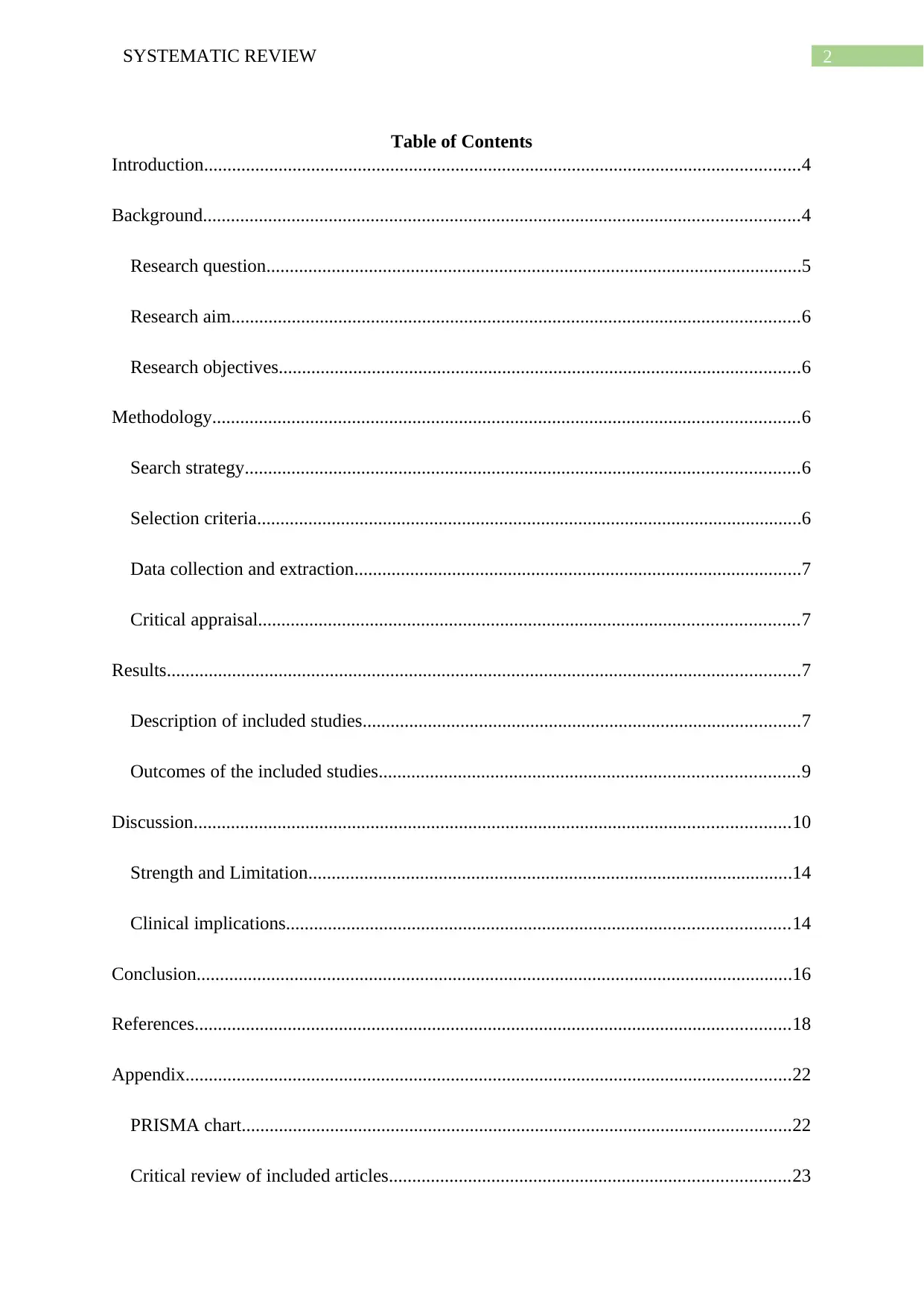
2SYSTEMATIC REVIEW
Table of Contents
Introduction................................................................................................................................4
Background................................................................................................................................4
Research question...................................................................................................................5
Research aim..........................................................................................................................6
Research objectives................................................................................................................6
Methodology..............................................................................................................................6
Search strategy.......................................................................................................................6
Selection criteria.....................................................................................................................6
Data collection and extraction................................................................................................7
Critical appraisal....................................................................................................................7
Results........................................................................................................................................7
Description of included studies..............................................................................................7
Outcomes of the included studies..........................................................................................9
Discussion................................................................................................................................10
Strength and Limitation........................................................................................................14
Clinical implications............................................................................................................14
Conclusion................................................................................................................................16
References................................................................................................................................18
Appendix..................................................................................................................................22
PRISMA chart......................................................................................................................22
Critical review of included articles......................................................................................23
Table of Contents
Introduction................................................................................................................................4
Background................................................................................................................................4
Research question...................................................................................................................5
Research aim..........................................................................................................................6
Research objectives................................................................................................................6
Methodology..............................................................................................................................6
Search strategy.......................................................................................................................6
Selection criteria.....................................................................................................................6
Data collection and extraction................................................................................................7
Critical appraisal....................................................................................................................7
Results........................................................................................................................................7
Description of included studies..............................................................................................7
Outcomes of the included studies..........................................................................................9
Discussion................................................................................................................................10
Strength and Limitation........................................................................................................14
Clinical implications............................................................................................................14
Conclusion................................................................................................................................16
References................................................................................................................................18
Appendix..................................................................................................................................22
PRISMA chart......................................................................................................................22
Critical review of included articles......................................................................................23
⊘ This is a preview!⊘
Do you want full access?
Subscribe today to unlock all pages.

Trusted by 1+ million students worldwide

3SYSTEMATIC REVIEW
Data extraction.....................................................................................................................54
Excluded Articles.................................................................................................................61
Data extraction.....................................................................................................................54
Excluded Articles.................................................................................................................61
Paraphrase This Document
Need a fresh take? Get an instant paraphrase of this document with our AI Paraphraser

4SYSTEMATIC REVIEW
Introduction
Graduated compression stockings refer to distinct stockings that work with the aim of
promoting circulation in the legs. In the veins that are located in the legs, blood must
typically flow upwards, in the direction of the heart (Priego et al. 2015). In other words,
graduated compression stockings have been found effective in applying a precise amount of
pressure, at regions near the ankles, followed by gradual application of pressure, of
decreasing intensity, while moving up the legs. Hence, the primary benefit of graduated
compression stocking can be accredited to the fact that they facilitate squeezing or pushing
blood from the ankles to the thighs, with the effort of counteracting blood pooling in the leg,
and the swelling that ensues (Beliard et al. 2015). This assignment will focus on a systematic
review that will be based on a thematic analysis on the effects of graduated compression
stockings on DVT.
Background
Deep Venous Thrombosis (DVT) encompasses situations where blood clot formation
occurs in deep veins that are most commonly located in the legs. In other words, DVT occurs
when thrombus or blood clot develops in one or more than one of deep veins that are located
primarily in the legs (Van Gent et al. 2014). Irish doctors typically estimate that there roughly
4,000 deaths occur every year due to DVT and pulmonary embolism (PE), which combined
together result in Venous Thromboembolism (VTE). Of these death rates, 1,900 deaths have
also been recognised as avoidable through novel treatment options, and better management,
pooled with patient knowledge and awareness (Thrombosisireland.ie 2018). Time and again
it has been proved that prolonged bed rest due to increased length of hospitalisation makes
the legs of the patients remain still for a considerable period of time.
Introduction
Graduated compression stockings refer to distinct stockings that work with the aim of
promoting circulation in the legs. In the veins that are located in the legs, blood must
typically flow upwards, in the direction of the heart (Priego et al. 2015). In other words,
graduated compression stockings have been found effective in applying a precise amount of
pressure, at regions near the ankles, followed by gradual application of pressure, of
decreasing intensity, while moving up the legs. Hence, the primary benefit of graduated
compression stocking can be accredited to the fact that they facilitate squeezing or pushing
blood from the ankles to the thighs, with the effort of counteracting blood pooling in the leg,
and the swelling that ensues (Beliard et al. 2015). This assignment will focus on a systematic
review that will be based on a thematic analysis on the effects of graduated compression
stockings on DVT.
Background
Deep Venous Thrombosis (DVT) encompasses situations where blood clot formation
occurs in deep veins that are most commonly located in the legs. In other words, DVT occurs
when thrombus or blood clot develops in one or more than one of deep veins that are located
primarily in the legs (Van Gent et al. 2014). Irish doctors typically estimate that there roughly
4,000 deaths occur every year due to DVT and pulmonary embolism (PE), which combined
together result in Venous Thromboembolism (VTE). Of these death rates, 1,900 deaths have
also been recognised as avoidable through novel treatment options, and better management,
pooled with patient knowledge and awareness (Thrombosisireland.ie 2018). Time and again
it has been proved that prolonged bed rest due to increased length of hospitalisation makes
the legs of the patients remain still for a considerable period of time.
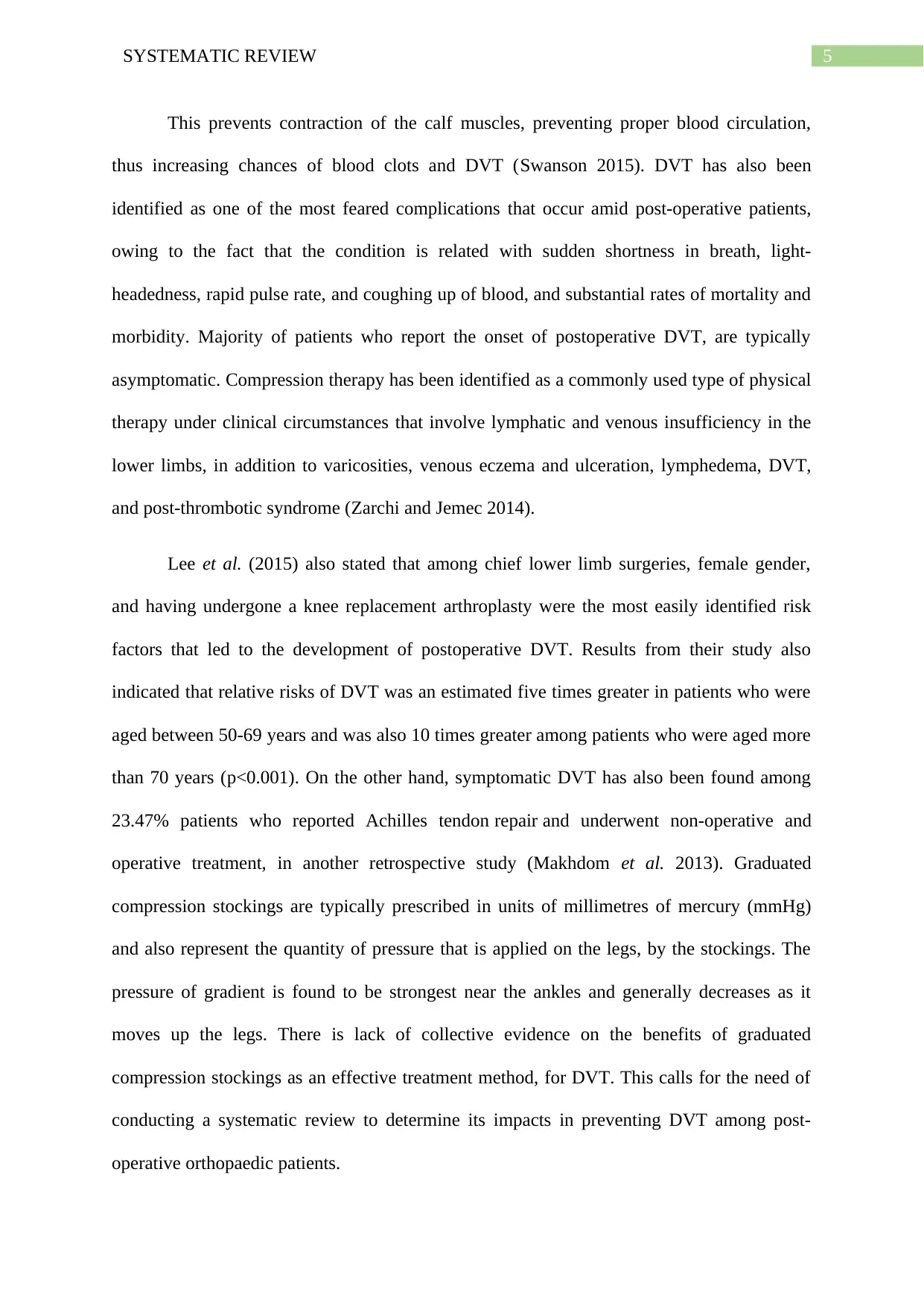
5SYSTEMATIC REVIEW
This prevents contraction of the calf muscles, preventing proper blood circulation,
thus increasing chances of blood clots and DVT (Swanson 2015). DVT has also been
identified as one of the most feared complications that occur amid post-operative patients,
owing to the fact that the condition is related with sudden shortness in breath, light-
headedness, rapid pulse rate, and coughing up of blood, and substantial rates of mortality and
morbidity. Majority of patients who report the onset of postoperative DVT, are typically
asymptomatic. Compression therapy has been identified as a commonly used type of physical
therapy under clinical circumstances that involve lymphatic and venous insufficiency in the
lower limbs, in addition to varicosities, venous eczema and ulceration, lymphedema, DVT,
and post-thrombotic syndrome (Zarchi and Jemec 2014).
Lee et al. (2015) also stated that among chief lower limb surgeries, female gender,
and having undergone a knee replacement arthroplasty were the most easily identified risk
factors that led to the development of postoperative DVT. Results from their study also
indicated that relative risks of DVT was an estimated five times greater in patients who were
aged between 50-69 years and was also 10 times greater among patients who were aged more
than 70 years (p<0.001). On the other hand, symptomatic DVT has also been found among
23.47% patients who reported Achilles tendon repair and underwent non-operative and
operative treatment, in another retrospective study (Makhdom et al. 2013). Graduated
compression stockings are typically prescribed in units of millimetres of mercury (mmHg)
and also represent the quantity of pressure that is applied on the legs, by the stockings. The
pressure of gradient is found to be strongest near the ankles and generally decreases as it
moves up the legs. There is lack of collective evidence on the benefits of graduated
compression stockings as an effective treatment method, for DVT. This calls for the need of
conducting a systematic review to determine its impacts in preventing DVT among post-
operative orthopaedic patients.
This prevents contraction of the calf muscles, preventing proper blood circulation,
thus increasing chances of blood clots and DVT (Swanson 2015). DVT has also been
identified as one of the most feared complications that occur amid post-operative patients,
owing to the fact that the condition is related with sudden shortness in breath, light-
headedness, rapid pulse rate, and coughing up of blood, and substantial rates of mortality and
morbidity. Majority of patients who report the onset of postoperative DVT, are typically
asymptomatic. Compression therapy has been identified as a commonly used type of physical
therapy under clinical circumstances that involve lymphatic and venous insufficiency in the
lower limbs, in addition to varicosities, venous eczema and ulceration, lymphedema, DVT,
and post-thrombotic syndrome (Zarchi and Jemec 2014).
Lee et al. (2015) also stated that among chief lower limb surgeries, female gender,
and having undergone a knee replacement arthroplasty were the most easily identified risk
factors that led to the development of postoperative DVT. Results from their study also
indicated that relative risks of DVT was an estimated five times greater in patients who were
aged between 50-69 years and was also 10 times greater among patients who were aged more
than 70 years (p<0.001). On the other hand, symptomatic DVT has also been found among
23.47% patients who reported Achilles tendon repair and underwent non-operative and
operative treatment, in another retrospective study (Makhdom et al. 2013). Graduated
compression stockings are typically prescribed in units of millimetres of mercury (mmHg)
and also represent the quantity of pressure that is applied on the legs, by the stockings. The
pressure of gradient is found to be strongest near the ankles and generally decreases as it
moves up the legs. There is lack of collective evidence on the benefits of graduated
compression stockings as an effective treatment method, for DVT. This calls for the need of
conducting a systematic review to determine its impacts in preventing DVT among post-
operative orthopaedic patients.
⊘ This is a preview!⊘
Do you want full access?
Subscribe today to unlock all pages.

Trusted by 1+ million students worldwide
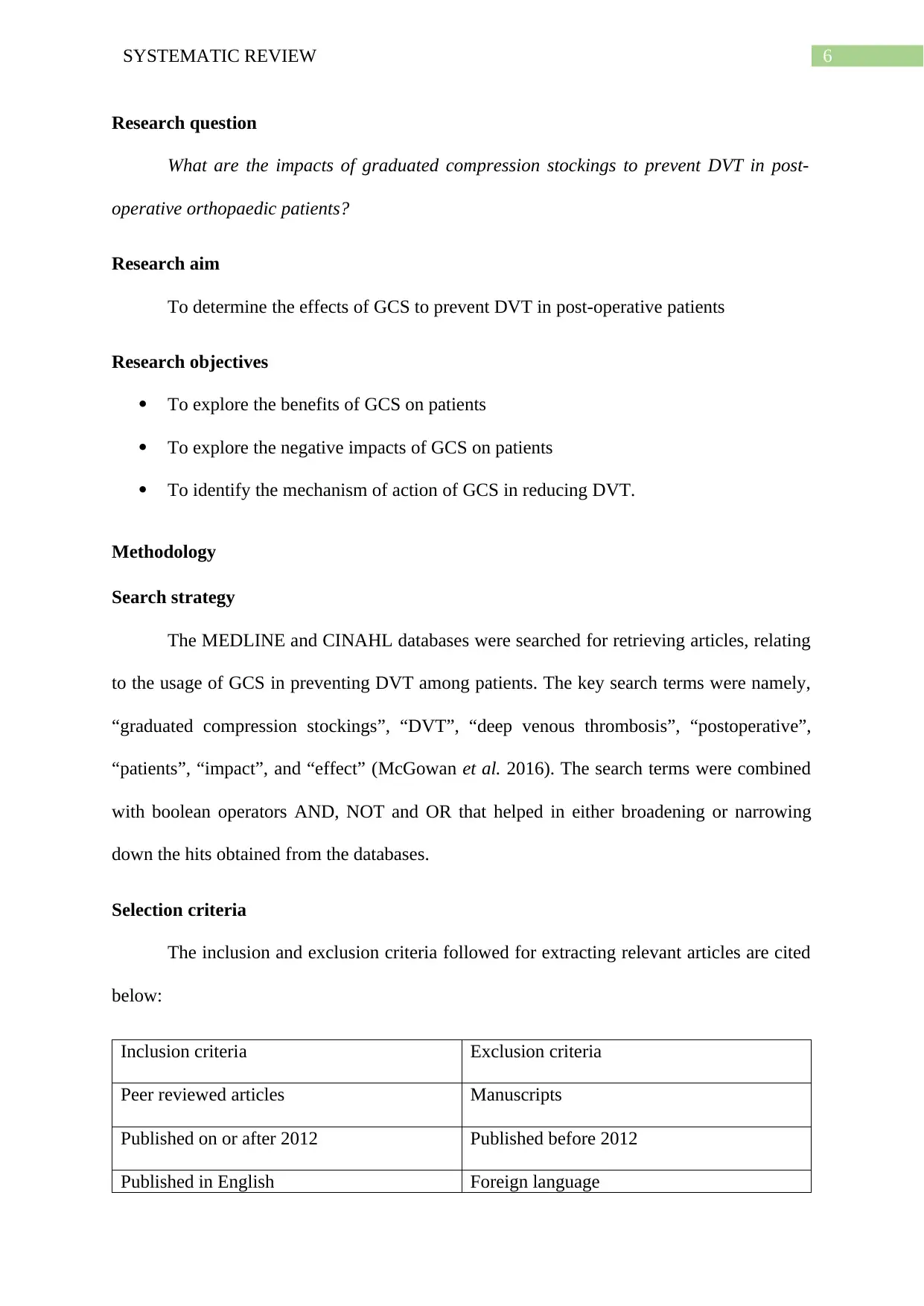
6SYSTEMATIC REVIEW
Research question
What are the impacts of graduated compression stockings to prevent DVT in post-
operative orthopaedic patients?
Research aim
To determine the effects of GCS to prevent DVT in post-operative patients
Research objectives
To explore the benefits of GCS on patients
To explore the negative impacts of GCS on patients
To identify the mechanism of action of GCS in reducing DVT.
Methodology
Search strategy
The MEDLINE and CINAHL databases were searched for retrieving articles, relating
to the usage of GCS in preventing DVT among patients. The key search terms were namely,
“graduated compression stockings”, “DVT”, “deep venous thrombosis”, “postoperative”,
“patients”, “impact”, and “effect” (McGowan et al. 2016). The search terms were combined
with boolean operators AND, NOT and OR that helped in either broadening or narrowing
down the hits obtained from the databases.
Selection criteria
The inclusion and exclusion criteria followed for extracting relevant articles are cited
below:
Inclusion criteria Exclusion criteria
Peer reviewed articles Manuscripts
Published on or after 2012 Published before 2012
Published in English Foreign language
Research question
What are the impacts of graduated compression stockings to prevent DVT in post-
operative orthopaedic patients?
Research aim
To determine the effects of GCS to prevent DVT in post-operative patients
Research objectives
To explore the benefits of GCS on patients
To explore the negative impacts of GCS on patients
To identify the mechanism of action of GCS in reducing DVT.
Methodology
Search strategy
The MEDLINE and CINAHL databases were searched for retrieving articles, relating
to the usage of GCS in preventing DVT among patients. The key search terms were namely,
“graduated compression stockings”, “DVT”, “deep venous thrombosis”, “postoperative”,
“patients”, “impact”, and “effect” (McGowan et al. 2016). The search terms were combined
with boolean operators AND, NOT and OR that helped in either broadening or narrowing
down the hits obtained from the databases.
Selection criteria
The inclusion and exclusion criteria followed for extracting relevant articles are cited
below:
Inclusion criteria Exclusion criteria
Peer reviewed articles Manuscripts
Published on or after 2012 Published before 2012
Published in English Foreign language
Paraphrase This Document
Need a fresh take? Get an instant paraphrase of this document with our AI Paraphraser
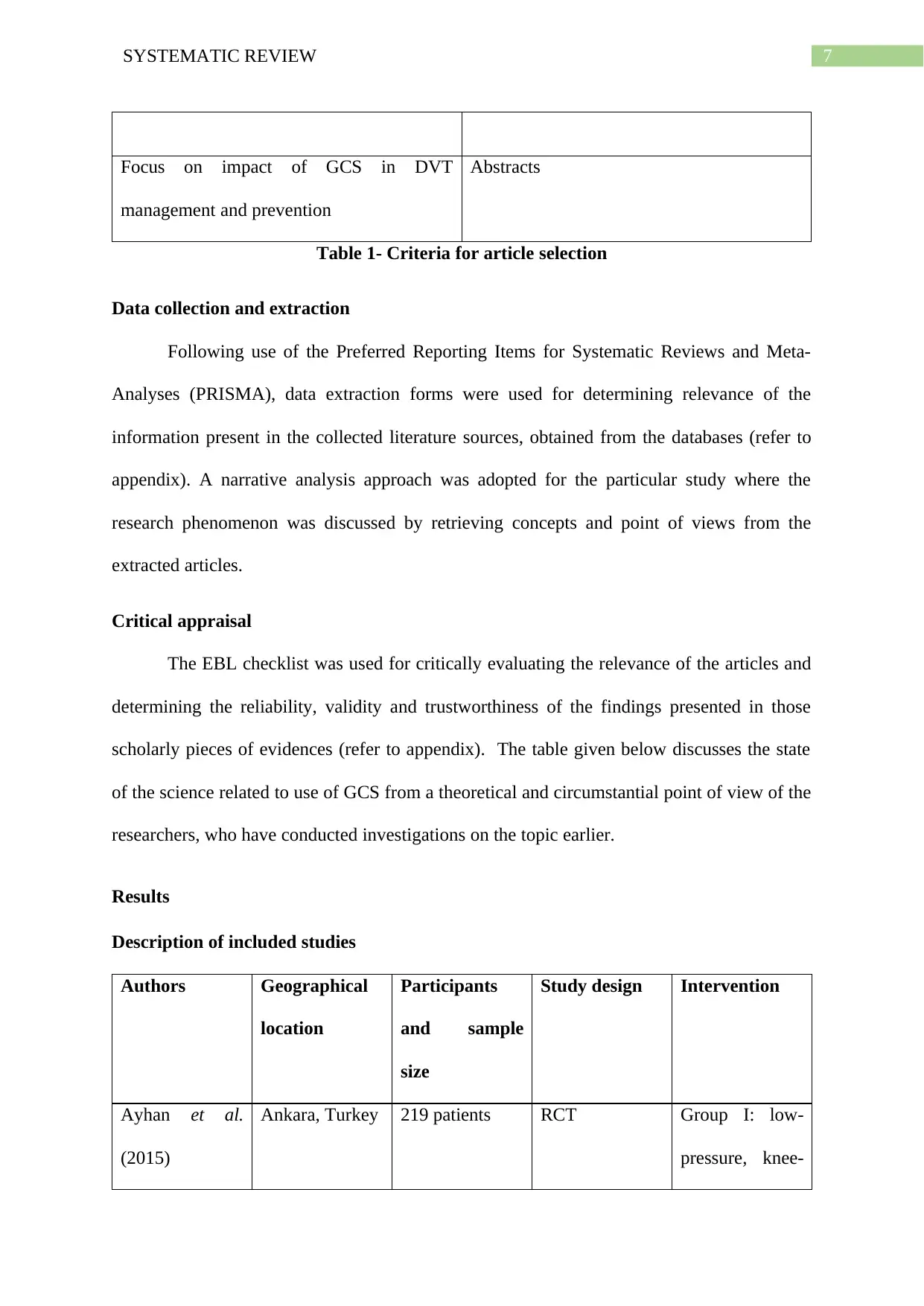
7SYSTEMATIC REVIEW
Focus on impact of GCS in DVT
management and prevention
Abstracts
Table 1- Criteria for article selection
Data collection and extraction
Following use of the Preferred Reporting Items for Systematic Reviews and Meta-
Analyses (PRISMA), data extraction forms were used for determining relevance of the
information present in the collected literature sources, obtained from the databases (refer to
appendix). A narrative analysis approach was adopted for the particular study where the
research phenomenon was discussed by retrieving concepts and point of views from the
extracted articles.
Critical appraisal
The EBL checklist was used for critically evaluating the relevance of the articles and
determining the reliability, validity and trustworthiness of the findings presented in those
scholarly pieces of evidences (refer to appendix). The table given below discusses the state
of the science related to use of GCS from a theoretical and circumstantial point of view of the
researchers, who have conducted investigations on the topic earlier.
Results
Description of included studies
Authors Geographical
location
Participants
and sample
size
Study design Intervention
Ayhan et al.
(2015)
Ankara, Turkey 219 patients RCT Group I: low-
pressure, knee-
Focus on impact of GCS in DVT
management and prevention
Abstracts
Table 1- Criteria for article selection
Data collection and extraction
Following use of the Preferred Reporting Items for Systematic Reviews and Meta-
Analyses (PRISMA), data extraction forms were used for determining relevance of the
information present in the collected literature sources, obtained from the databases (refer to
appendix). A narrative analysis approach was adopted for the particular study where the
research phenomenon was discussed by retrieving concepts and point of views from the
extracted articles.
Critical appraisal
The EBL checklist was used for critically evaluating the relevance of the articles and
determining the reliability, validity and trustworthiness of the findings presented in those
scholarly pieces of evidences (refer to appendix). The table given below discusses the state
of the science related to use of GCS from a theoretical and circumstantial point of view of the
researchers, who have conducted investigations on the topic earlier.
Results
Description of included studies
Authors Geographical
location
Participants
and sample
size
Study design Intervention
Ayhan et al.
(2015)
Ankara, Turkey 219 patients RCT Group I: low-
pressure, knee-
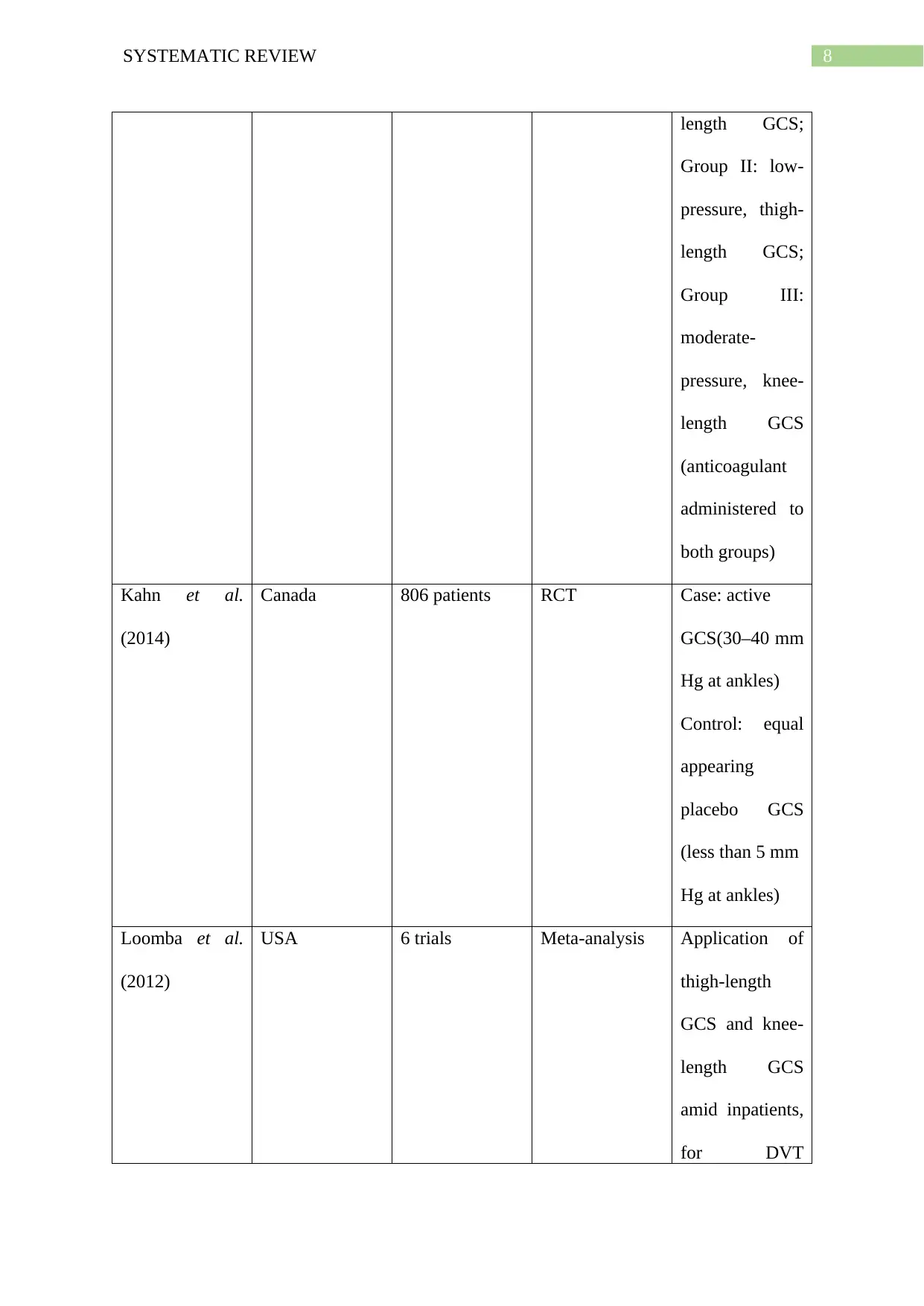
8SYSTEMATIC REVIEW
length GCS;
Group II: low-
pressure, thigh-
length GCS;
Group III:
moderate-
pressure, knee-
length GCS
(anticoagulant
administered to
both groups)
Kahn et al.
(2014)
Canada 806 patients RCT Case: active
GCS(30–40 mm
Hg at ankles)
Control: equal
appearing
placebo GCS
(less than 5 mm
Hg at ankles)
Loomba et al.
(2012)
USA 6 trials Meta-analysis Application of
thigh-length
GCS and knee-
length GCS
amid inpatients,
for DVT
length GCS;
Group II: low-
pressure, thigh-
length GCS;
Group III:
moderate-
pressure, knee-
length GCS
(anticoagulant
administered to
both groups)
Kahn et al.
(2014)
Canada 806 patients RCT Case: active
GCS(30–40 mm
Hg at ankles)
Control: equal
appearing
placebo GCS
(less than 5 mm
Hg at ankles)
Loomba et al.
(2012)
USA 6 trials Meta-analysis Application of
thigh-length
GCS and knee-
length GCS
amid inpatients,
for DVT
⊘ This is a preview!⊘
Do you want full access?
Subscribe today to unlock all pages.

Trusted by 1+ million students worldwide
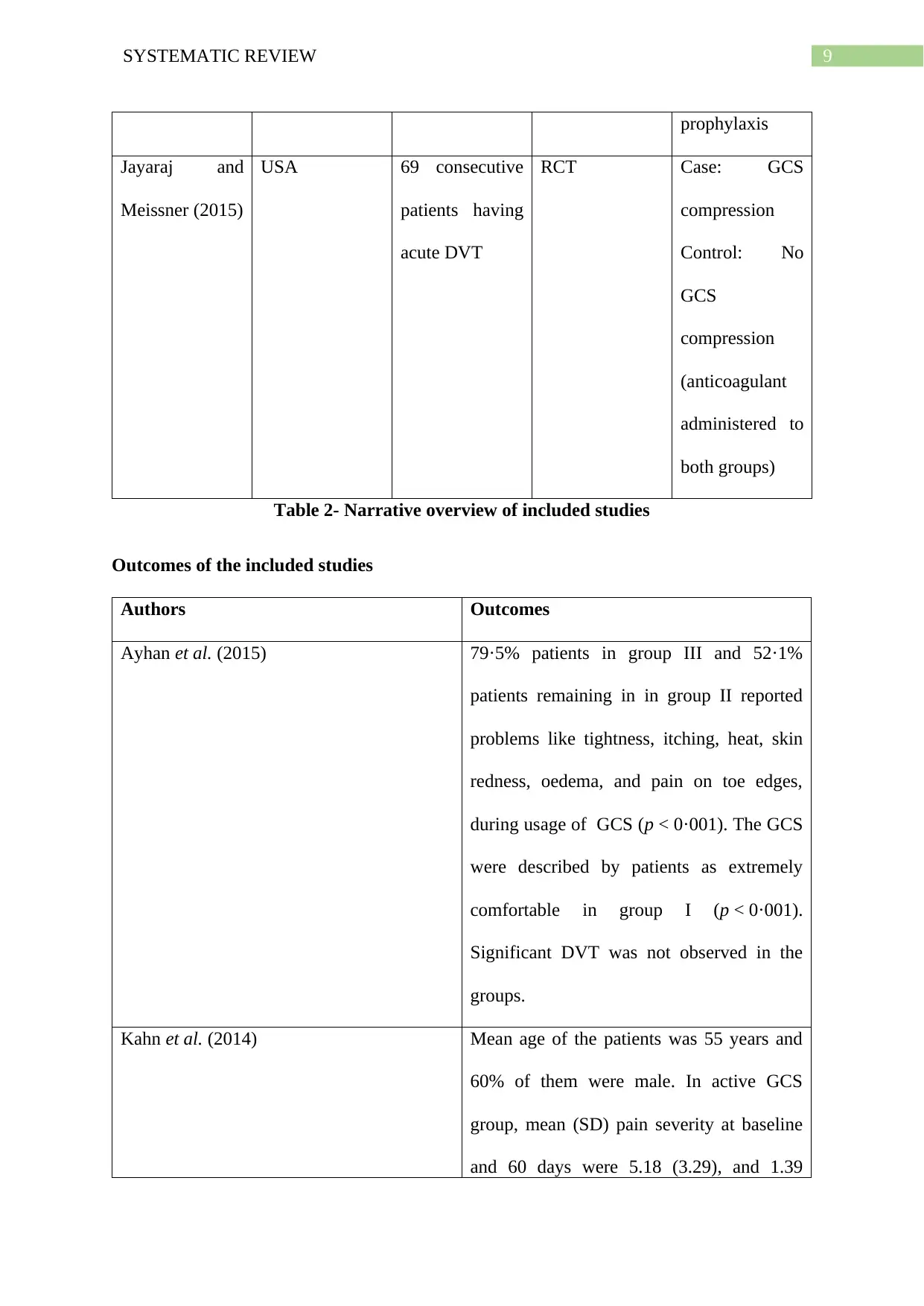
9SYSTEMATIC REVIEW
prophylaxis
Jayaraj and
Meissner (2015)
USA 69 consecutive
patients having
acute DVT
RCT Case: GCS
compression
Control: No
GCS
compression
(anticoagulant
administered to
both groups)
Table 2- Narrative overview of included studies
Outcomes of the included studies
Authors Outcomes
Ayhan et al. (2015) 79·5% patients in group III and 52·1%
patients remaining in in group II reported
problems like tightness, itching, heat, skin
redness, oedema, and pain on toe edges,
during usage of GCS (p < 0·001). The GCS
were described by patients as extremely
comfortable in group I (p < 0·001).
Significant DVT was not observed in the
groups.
Kahn et al. (2014) Mean age of the patients was 55 years and
60% of them were male. In active GCS
group, mean (SD) pain severity at baseline
and 60 days were 5.18 (3.29), and 1.39
prophylaxis
Jayaraj and
Meissner (2015)
USA 69 consecutive
patients having
acute DVT
RCT Case: GCS
compression
Control: No
GCS
compression
(anticoagulant
administered to
both groups)
Table 2- Narrative overview of included studies
Outcomes of the included studies
Authors Outcomes
Ayhan et al. (2015) 79·5% patients in group III and 52·1%
patients remaining in in group II reported
problems like tightness, itching, heat, skin
redness, oedema, and pain on toe edges,
during usage of GCS (p < 0·001). The GCS
were described by patients as extremely
comfortable in group I (p < 0·001).
Significant DVT was not observed in the
groups.
Kahn et al. (2014) Mean age of the patients was 55 years and
60% of them were male. In active GCS
group, mean (SD) pain severity at baseline
and 60 days were 5.18 (3.29), and 1.39
Paraphrase This Document
Need a fresh take? Get an instant paraphrase of this document with our AI Paraphraser

10SYSTEMATIC REVIEW
(2.19), respectively. On the other hand, in
the placebo GCS group, mean (SD) pain
severity at baseline and 60 days were 5.38
(3.29) and 1.13 (1.86), respectively. No
important differences were observed in the
pain scores between the two groups at any
point.
Jayaraj and Meissner (2015) An analysis of both Villalta-Prandoni Score
and Venous Clinical Severity scores
suggested lack of differences between post-
thrombotic DVT between groups. Burden of
post-thrombotic syndrome was
meaningfully higher for Villalta-Prandoni
Score instrument (∼75%) in comparison to
Venous Clinical Severity Score instrument
(∼30%) during follow-up.
Loomba et al. (2012) Usage of a fixed-effects model suggested
that upon comparing both knee-length and
thigh-length GCS, thigh-length GCS were
found to offer a reduction in risk of
developing DVT, in contrast to the former
GCS (odds ratio 1.197, confidence interval
0.983–1.458). Nonetheless, the finding was
insignificant.
Table 2- Overview of outcomes
(2.19), respectively. On the other hand, in
the placebo GCS group, mean (SD) pain
severity at baseline and 60 days were 5.38
(3.29) and 1.13 (1.86), respectively. No
important differences were observed in the
pain scores between the two groups at any
point.
Jayaraj and Meissner (2015) An analysis of both Villalta-Prandoni Score
and Venous Clinical Severity scores
suggested lack of differences between post-
thrombotic DVT between groups. Burden of
post-thrombotic syndrome was
meaningfully higher for Villalta-Prandoni
Score instrument (∼75%) in comparison to
Venous Clinical Severity Score instrument
(∼30%) during follow-up.
Loomba et al. (2012) Usage of a fixed-effects model suggested
that upon comparing both knee-length and
thigh-length GCS, thigh-length GCS were
found to offer a reduction in risk of
developing DVT, in contrast to the former
GCS (odds ratio 1.197, confidence interval
0.983–1.458). Nonetheless, the finding was
insignificant.
Table 2- Overview of outcomes
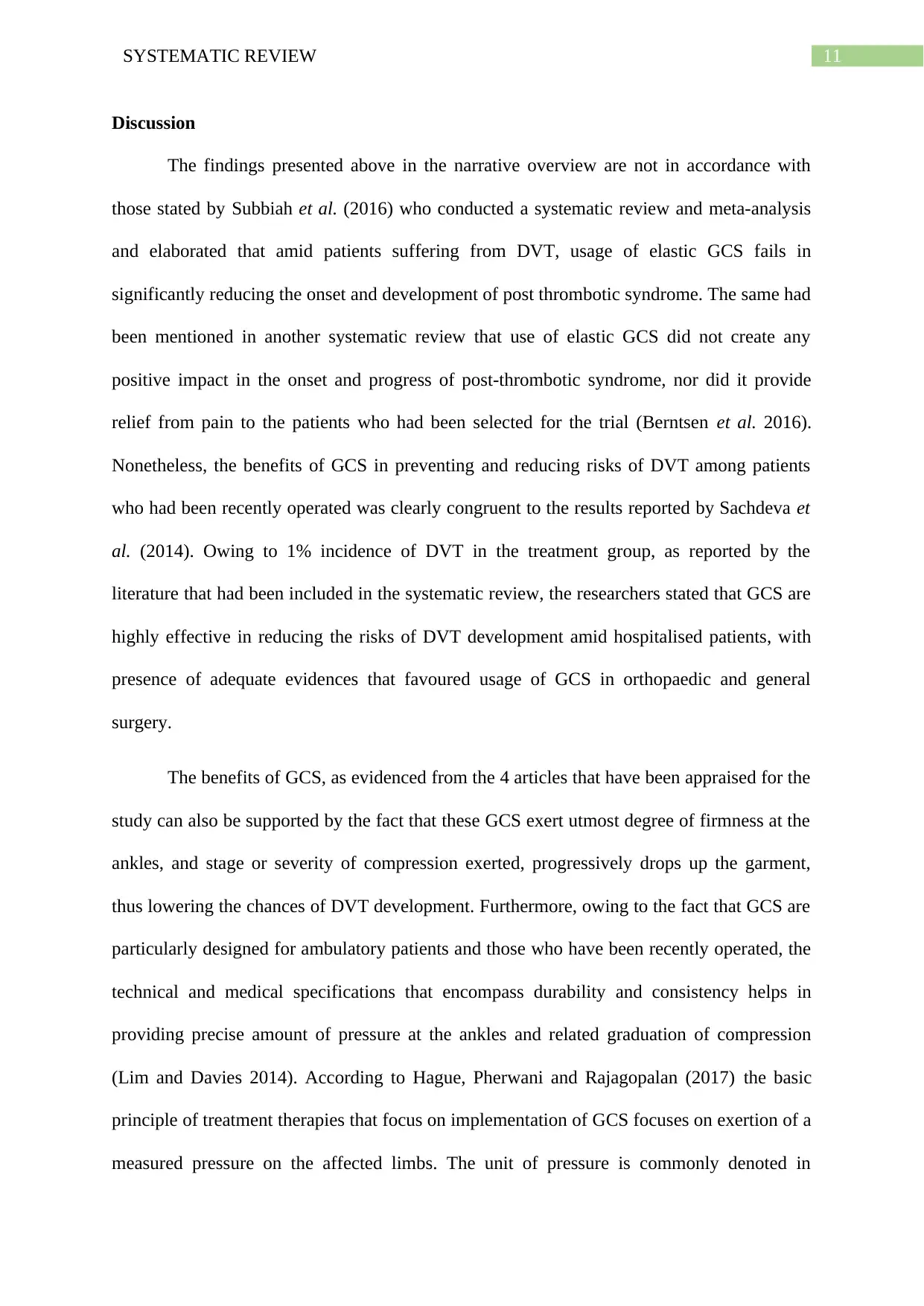
11SYSTEMATIC REVIEW
Discussion
The findings presented above in the narrative overview are not in accordance with
those stated by Subbiah et al. (2016) who conducted a systematic review and meta-analysis
and elaborated that amid patients suffering from DVT, usage of elastic GCS fails in
significantly reducing the onset and development of post thrombotic syndrome. The same had
been mentioned in another systematic review that use of elastic GCS did not create any
positive impact in the onset and progress of post-thrombotic syndrome, nor did it provide
relief from pain to the patients who had been selected for the trial (Berntsen et al. 2016).
Nonetheless, the benefits of GCS in preventing and reducing risks of DVT among patients
who had been recently operated was clearly congruent to the results reported by Sachdeva et
al. (2014). Owing to 1% incidence of DVT in the treatment group, as reported by the
literature that had been included in the systematic review, the researchers stated that GCS are
highly effective in reducing the risks of DVT development amid hospitalised patients, with
presence of adequate evidences that favoured usage of GCS in orthopaedic and general
surgery.
The benefits of GCS, as evidenced from the 4 articles that have been appraised for the
study can also be supported by the fact that these GCS exert utmost degree of firmness at the
ankles, and stage or severity of compression exerted, progressively drops up the garment,
thus lowering the chances of DVT development. Furthermore, owing to the fact that GCS are
particularly designed for ambulatory patients and those who have been recently operated, the
technical and medical specifications that encompass durability and consistency helps in
providing precise amount of pressure at the ankles and related graduation of compression
(Lim and Davies 2014). According to Hague, Pherwani and Rajagopalan (2017) the basic
principle of treatment therapies that focus on implementation of GCS focuses on exertion of a
measured pressure on the affected limbs. The unit of pressure is commonly denoted in
Discussion
The findings presented above in the narrative overview are not in accordance with
those stated by Subbiah et al. (2016) who conducted a systematic review and meta-analysis
and elaborated that amid patients suffering from DVT, usage of elastic GCS fails in
significantly reducing the onset and development of post thrombotic syndrome. The same had
been mentioned in another systematic review that use of elastic GCS did not create any
positive impact in the onset and progress of post-thrombotic syndrome, nor did it provide
relief from pain to the patients who had been selected for the trial (Berntsen et al. 2016).
Nonetheless, the benefits of GCS in preventing and reducing risks of DVT among patients
who had been recently operated was clearly congruent to the results reported by Sachdeva et
al. (2014). Owing to 1% incidence of DVT in the treatment group, as reported by the
literature that had been included in the systematic review, the researchers stated that GCS are
highly effective in reducing the risks of DVT development amid hospitalised patients, with
presence of adequate evidences that favoured usage of GCS in orthopaedic and general
surgery.
The benefits of GCS, as evidenced from the 4 articles that have been appraised for the
study can also be supported by the fact that these GCS exert utmost degree of firmness at the
ankles, and stage or severity of compression exerted, progressively drops up the garment,
thus lowering the chances of DVT development. Furthermore, owing to the fact that GCS are
particularly designed for ambulatory patients and those who have been recently operated, the
technical and medical specifications that encompass durability and consistency helps in
providing precise amount of pressure at the ankles and related graduation of compression
(Lim and Davies 2014). According to Hague, Pherwani and Rajagopalan (2017) the basic
principle of treatment therapies that focus on implementation of GCS focuses on exertion of a
measured pressure on the affected limbs. The unit of pressure is commonly denoted in
⊘ This is a preview!⊘
Do you want full access?
Subscribe today to unlock all pages.

Trusted by 1+ million students worldwide
1 out of 65
Related Documents
Your All-in-One AI-Powered Toolkit for Academic Success.
+13062052269
info@desklib.com
Available 24*7 on WhatsApp / Email
![[object Object]](/_next/static/media/star-bottom.7253800d.svg)
Unlock your academic potential
Copyright © 2020–2025 A2Z Services. All Rights Reserved. Developed and managed by ZUCOL.





